Dysrhythmia and pacemaker - Study guides, Class notes & Summaries
Looking for the best study guides, study notes and summaries about Dysrhythmia and pacemaker? On this page you'll find 1284 study documents about Dysrhythmia and pacemaker.
Page 2 out of 1.284 results
Sort by
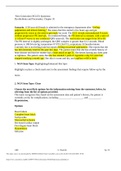
-
Next Generation NCLEX Questions Dysrhythmia and Pacemaker, Chapter 35
- Exam (elaborations) • 3 pages • 2023
-
- $10.49
- + learn more
Scenario: A 38-year-old female is admitted to the emergency department after “feeling palpitations and almost fainting.” She states that this started a few hours ago and got progressively worse as she tried to get ready for work. The ECG reveals nonconducted P waves without progressive PR intervals. On conducted beats, the PR interval is constant, with a ratio of 3:1 (three P waves to one conducted QRS interval). The ventricular rate ranges from 50 to 60. The PR interval is slightly pro...
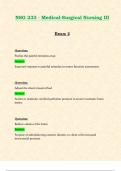
-
NSG233 / NSG 233 Exam 2 (Latest 2024 / 2025 Update): Medical-Surgical Nursing III | Questions and Verified Answers | 100% Correct | Grade A - Herzing
- Exam (elaborations) • 24 pages • 2024
- Available in package deal
-
- $7.99
- + learn more
Exam 2: NSG233 / NSG 233 (Latest 2024 / 2025 Update) Medical-Surgical Nursing III / Med Surg 3 Exam | Questions and Verified Answers | 100% Correct | Grade A - Herzing Q: Pushes the painful stimulus away Answer: Expected response to painful stimulus in motor function assessment. Q: Adjust the client's head of bed Answer: Action to maintain cerebral perfusion pressure in severe traumatic brain injury. Q: Reduce edema of the brain Answer: Purpose of administering osmotic diuretic to client with i...

-
Exam 3: NUR 3219C (Latest 2024- 2025 Update) Adult Acute Conditions | Exam Prep Questions and Verified Answers- Grade A -100% Correct
- Exam (elaborations) • 77 pages • 2024
-
- $11.49
- + learn more
Exam 3: NUR 3219C (Latest Update) Adult Acute Conditions | Exam Prep Questions and Verified Answers- Grade A -100% Correct Q: The part of the vascular system responsible for hemostasis is the a. thin capillary vessels. b. endothelial layer of the arteries. c. elastic middle layer of the veins. d. smooth muscle of the arterial wall. Answer: b. endothelial layer of the arteries. Q: When a person's blood pressure rises, the homeostatic mechanism to compensate for an elevat...
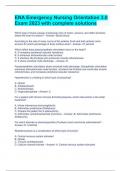
-
ENA Emergency Nursing Orientation 3.0 Exam 2023 with complete solutions
- Exam (elaborations) • 51 pages • 2023
-
Available in package deal
-
- $14.99
- 1x sold
- + learn more
Which type of shock causes a temporary loss of motor, sensory, and reflex functions below the level of a lesion? - Answer- Spinal shock According to the rule of nines, burns of the anterior trunk and both anterior arms account for which percentage of body surface area? - Answer- 27 percent Which effect does parasympathetic stimulation have on the heart? A. It increases peripheral vascular resistance. B. It enhances atrioventricular node function. C. It shortens His-Purkinje and ventric...
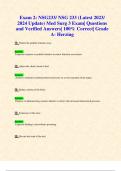
-
Exam 2: NSG233/ NSG 233 (Latest 2023/ 2024 Update) Med Surg 3 Exam| Questions and Verified Answers| 100% Correct| Grade A- Herzing
- Exam (elaborations) • 18 pages • 2024
-
Available in package deal
-
- $10.99
- + learn more
Exam 2: NSG233/ NSG 233 (Latest 2023/ 2024 Update) Med Surg 3 Exam| Questions and Verified Answers| 100% Correct| Grade A- Herzing Q: Pushes the painful stimulus away Answer: Expected response to painful stimulus in motor function assessment. Q: Adjust the client's head of bed Answer: Action to maintain cerebral perfusion pressure in severe traumatic brain injury. Q: Reduce edema of the brain Answer: Purpose of administering osmotic diuretic to client with ...
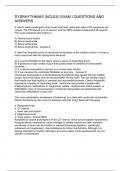
-
DYSRHYTHMIAS (NCLEX) EXAM I QUESTIONS AND ANSWERS
- Exam (elaborations) • 13 pages • 2024
-
- $12.99
- + learn more
A client's electrocardiogram strip shows atrial and ventricular rates of 80 complexes per minute. The PR interval is 0.14 second, and the QRS complex measures 0.08 second. The nurse interprets this rhythm is: A) Normal sinus rhythm B) Sinus bradycardia C) Sinus tachycardia D) Sinus dysrhythmia - Answer-A A client has frequent bursts of ventricular tachycardia on the cardiac monitor. A nurse is most concerned with this dysrhythmia because: A) It is uncomfortable for the client, givin...
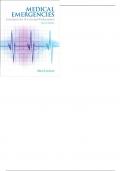
-
Medical Emergencies Essentials for the Dental Professional, 2Nd Ed Grimes -Test Bank
- Exam (elaborations) • 86 pages • 2023
-
Available in package deal
-
- $33.18
- 1x sold
- + learn more
Test Bank CHAPTER 1 Multiple Choice 1. What is the MOST common emergency to occur in the dental office? A. Mild allergic reaction B. Angina C. Syncope D. Anaphylaxis 2. All of the following procedures will help to prevent an emergency in a dental office EXCEPT: A. accurate medical history taking. B. taking and recording vital signs. C. updating the medical emergency kit. 3. If a patient responds positively on his or her medical history to epilepsy, you will need to be on th...
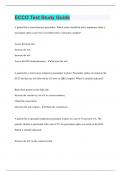
-
ECCO Test Study Guide
- Exam (elaborations) • 85 pages • 2024
-
- $11.99
- + learn more
ECCO Test Study Guide A patient has a transcutaneous pacemaker. Which action should the nurse implement when a pacemaker spike occurs but is not followed by ventricular complex? Assess the heart rate Increase the mA Increase the mV Assess the ECG lead placement - Increase the mA A patient has a transvenous temporary pacemaker in place. Pacemaker spikes are noted on the ECG, but they are not followed by a P wave or QRS complex. Which is initially indicated? Reposition patient on ...
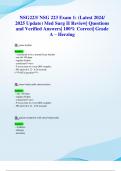
-
NSG223/ NSG 223 Exam 1: (Latest 2024/ 2025 Update) Med Surg II Review| Questions and Verified Answers| 100% Correct| Grade A – Herzing
- Exam (elaborations) • 20 pages • 2024
-
Available in package deal
-
- $10.99
- + learn more
NSG223/ NSG 223 Exam 1: (Latest 2024/ 2025 Update) Med Surg II Review| Questions and Verified Answers| 100% Correct| Grade A – Herzing Q: sinus rhythm - considered to be a normal heart rhythm - rate 60-100 bpm - regular rhythm - consistent P wave - P wave prior to every QRS complex - PR interval 0.12 - 0.20 seconds (***SATA question***) Q: sinus bradycardia characteristics Answer: - rate <60 bpm - regular rhythm - consistent P wave - P wave prior to every QRS complex...
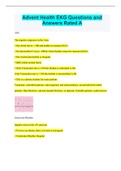
-
Advent Health EKG Questions and Answers Rated A
- Exam (elaborations) • 20 pages • 2023
-
Available in package deal
-
- $9.49
- 1x sold
- + learn more
Advent Health EKG Questions and Answers Rated A Afib The impulse originates in the Atria • The Atrial rate is > 300 and unable to measure [N/A] • No discernable P waves - PRI & Atrial rhythm cannot be measured [N/A] • The Ventricular rhythm is irregular • QRS within normal limits • If the Ventricular rate is <100 the rhythm is controlled A-fib; if the Ventricular rate is > 100 the rhythm is uncontrolled A-fib • This is a chronic rhythm for some patients Treatment: controlle...

That summary you just bought made someone very happy. Also get paid weekly? Sell your study resources on Stuvia! Discover all about earning on Stuvia


